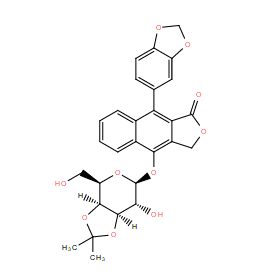| Cas No.: | 2130033-55-3 |
| Chemical Name: | 9-(benzo[d][1,3]dioxol-5-yl)-4-(((3aS,4R,6S,7R,7aR)-7-hydroxy-4-(hydroxymethyl)-2,2-dimethyltetrahydro-4H-[1,3]dioxolo[4,5-c]pyran-6-yl)oxy)naphtho[2,3-c]furan-1(3H)-one |
| SMILES: | O1CC2=C(O[C@H]3O[C@@H](CO)[C@]([H])4OC(C)(C)O[C@@]4([H])[C@@H]3O)C3C(C(C4C=C5C(=CC=4)OCO5)=C2C1=O)=CC=CC=3 |
| Formula: | C28H26O10 |
| M.Wt: | 522.506 |
| Purity: | >98% |
| Sotrage: | 2 years -20°C Powder, 2 weeks 4°C in DMSO, 6 months -80°C in DMSO |
| Description: | PHY34 is a potent autophagy inhibitor with cytotoxic effects by inhibiting autophagy at a late stage (MDA-MB-435 IC50=23 nM, MDA-MB-231 IC50=5.2 nM); disrupts lysosomal function, significantly inhibits the growth of cancer cell lines in hollow fibers, as well as reduces ovarian tumor burden in a xenograft model. |

 DC Chemicals' products qualify for U.S. tariff exemptions. We guarantee no price increases due to customs duties and maintain stable supply, continuing to deliver reliable research solutions to our American clients.
DC Chemicals' products qualify for U.S. tariff exemptions. We guarantee no price increases due to customs duties and maintain stable supply, continuing to deliver reliable research solutions to our American clients.





















